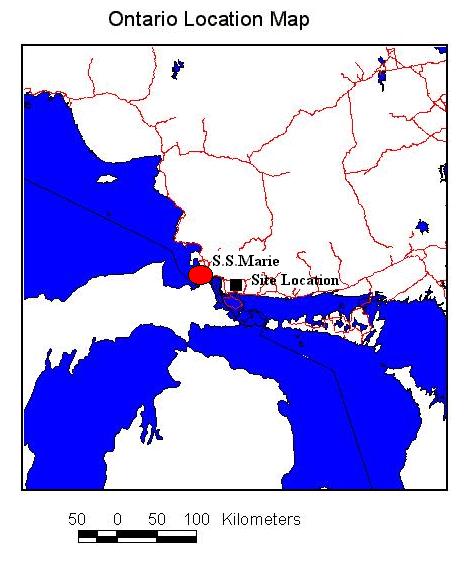 |
Signs of Early Precambrian Life?
'Stromatoforms' in the Lorrain Formation, Cobalt Group, Huronian Supergroup
Sault Ste. Marie, Ontario, Canada
Stromatoforms have been found on bedding plane surfaces of the upper white quartzite member of the Lorrain Formation on the north side of Gordon Lake, 50 km east of Sault Ste. Marie Ontario, Canada.
The Lorrain Formation forms the upper part of the Cobalt Group near the top of the Huronian Supergroup and is characterized by a basal arkose with middle red bed and conglomerate members capped by the white quartzite member containing the stromatoforms. The Lorrain Formation is considered to be primarily of fluvial origin in this area. The Huronian Supergroup is paleoproterozoic in age (2.4 - 2.2 b.y.).
The stromatoforms are composed of massive specular hematite characterized by a circular to oval shape in plan view and lense-like shape in section view. The specular hematite is characterized by a circular, thinly layered morphology with the cores of the 'lenses' being quartzite rich, but still displaying a layered form. These types of circular sedimentary structures where also identified in the upper red quartzite member (below the upper white quartzite) in the Wakomata Lake area by Siemiatkowska (1978). Other geologists have noted similar features within the Lorrain Formation at this and other locations (Frarey (1977), Tortosa (1984)),
The stromatoforms are located on bedding surfaces which are characterized by trough cross bedding and are stratigraphically within a meter of bedding surfaces characterized by well developed asymetrical ripple marks. The upper white quartzite in the immediate area is also characterized by large areas with variable amounts of disseminated specular hematite which impart a purplish hue to the rock. In places, specular hematite is closely associated with fractures and is disseminated in the quartzite on both sides of the fracture and as fracture filling.
When first seen on the well-exposed outcrop, the stromatoforms are very striking because of the dark purple colour of the specular hematite against the generally white quartzite background. They also appear to occur in clumps on the bedding plane surface, and specifically within some of the trough cross beds containing visible amounts of sericite forming part of the matrix. The layered morphology along with the 'convex' shape of some well-preserved stromatoforms suggest similarities with the classic examples of precambrian stromatolites described in the literature.
The white quartzite displays well developed ball and pillow sedimentary structures at other localities, but these can be easily identified as sedimentary in origin and there is no associated specular hematite. Although there may well be other explanations which reflect a sedimentary origin, it is intriguing to consider whether these features might not be of a shallow water biogenic origin. There appear to be few examples of stromatolites occuring within quartz-rich rocks formed in fluviatile to near shore marine environments. The Gordon Lake Formation consisting of thinly interlayered siltstone, quartzite and green chert, immediately overlies the Lorrain Formation in this area and is within 30 metres stratigraphically above the stromatoform beds. The Gordon Lake Formation is considered to be near shore marine.
References:
Siemiatkowska, K.M. (1977): Geology of the Wakomata Lake Area, District of Algoma; Ontario Geological Survey, Geoscience Report 151.
Frarey, M.J. (1977): Geology of the Huronian Belt between Sault Ste. Marie and Sudbury; Geological Survey of Canada, Memoir 383, 87 p.
Tortosa, D. (1984): Lithogeochemistry of the Huronian Supergroup, Bruce Mines and Whitefish Falls areas, Northern Ontario; Geological Survey of Canada, Open File 1089, 77 p. 4 maps.
Comments on these images or on early precambrian life can be sent to Delio Tortosa at eliris@soonet.ca
Photos courtesy of M. Hailstone, District Geologist, Ministry of Northern Development and Mines, Sault Ste. Marie, Ontario
Last Updated: April 12, 2000